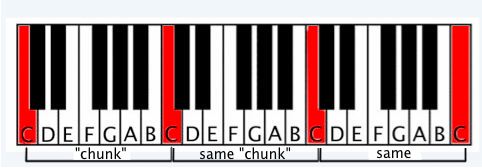This is the third of a 7-part intro-series on how to play by piano by learning music as a language - the piano couture approach. access all the lessons in this series by joining the couture (it's free)
Hi there!
Welcome to lesson three of the Hack the Piano Launchpad, the intro course to playing piano by ear.
Last lesson, I showed you:
- The layout of the Keyboard and how to quickly find and remember any white key.
- The concept of “Chunking”
- Your very first two Chords
- How to use them to play the majority of happy birthday.
In this lesson I’ll show you:
- How to finish happy b-day
- A new chord – the last chord you’ll need to play Happy birthday in its full –
- This in turn will show you the one of the many aspects of chord versatility: you can use them to “scale” a tune to your current level (which means you’ll actually be able to play anything you want really soon)
- A convenient “trick” to find and remember our first basic form of chords
- Bass – how cool it is and how to play it
- Play an entirely new song using these exact same chords.
- -> chords are like words, re-usable in many different sentences and conversations.
So let’s recap real quickly:
Here’s the names of the white keys.
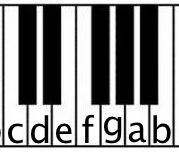 Remember that it’s only this chunk of the board that makes up the actual layout. After remembering that, it’s just a matter of copy-pasting it all over the board.
Remember that it’s only this chunk of the board that makes up the actual layout. After remembering that, it’s just a matter of copy-pasting it all over the board.
When we want to play a C chord, we look for the note “c,” and start building the chord by playing that note (the “c”) then skipping a note (not playing the “d”), playing the next (the “e”) skipping one more note (omitting the “f”) and then playing the next again (the “g”).
So this way a chord is formed by playing three notes, starting on the note that it’s called from and leaving one note open between each of the notes played, like this:
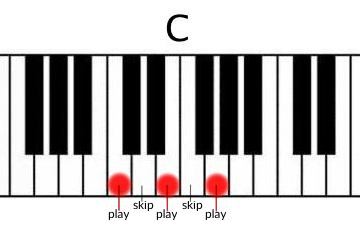
If you look at the form of the G chord that we played after that, you might notice that it’s form resembles the form of this C chord quite a lot, don’t you think?
 Take close note of this form when we get back to Happy Birthday again and finish off this song so you can impress someone on his or her birthday:
Take close note of this form when we get back to Happy Birthday again and finish off this song so you can impress someone on his or her birthday:
That last chord is called the F chord, and as you might have noticed is built the exact same way again, now starting on “f” – obviously.
C -> start on “c” & play, skip, play (“e”), skip, play (“g”).
G -> start on “g” & play, skip, play, skip, play.
F -> start on “f” and do the same.
All three of these chords can be explained as built by: playing a note, skipping a note, playing a note, skipping a note, playing a note – remember this to be able to re-construct yourself.
They’re named after their lowest note – which we’ll double by also playing it with the left hand, like this:
 Adding Bass
Adding Bass
The easiest explanation – which for this moment perfectly suffices – of “Bass” in music is the lowest note that is played.
It’s the “founding” note(s) of music.
Bass is often played with a bass guitar or a synthesizer, but on the piano we have the great fortune of being able to play those low notes as well, with our -up until this point- lazy left hand.
Remember that to play a C chord we have to start on “c” – meaning our lowest note is a “c.”
Since the left hand plays even lower than the bottom note of our right, this is the actual “start” of the chord and adding the appropriate bass note is therefore as easy as playing the root of the chord – the note that the chord is named after – low on the keyboard.
How low, you ask? Well, let’s try one “chunk” – called an “octave” – lower.
 Let’s try and play the whole Happy Birthday round with the left hand playing the roots of all three chords.
Let’s try and play the whole Happy Birthday round with the left hand playing the roots of all three chords.
Sing along while you’re playing this!
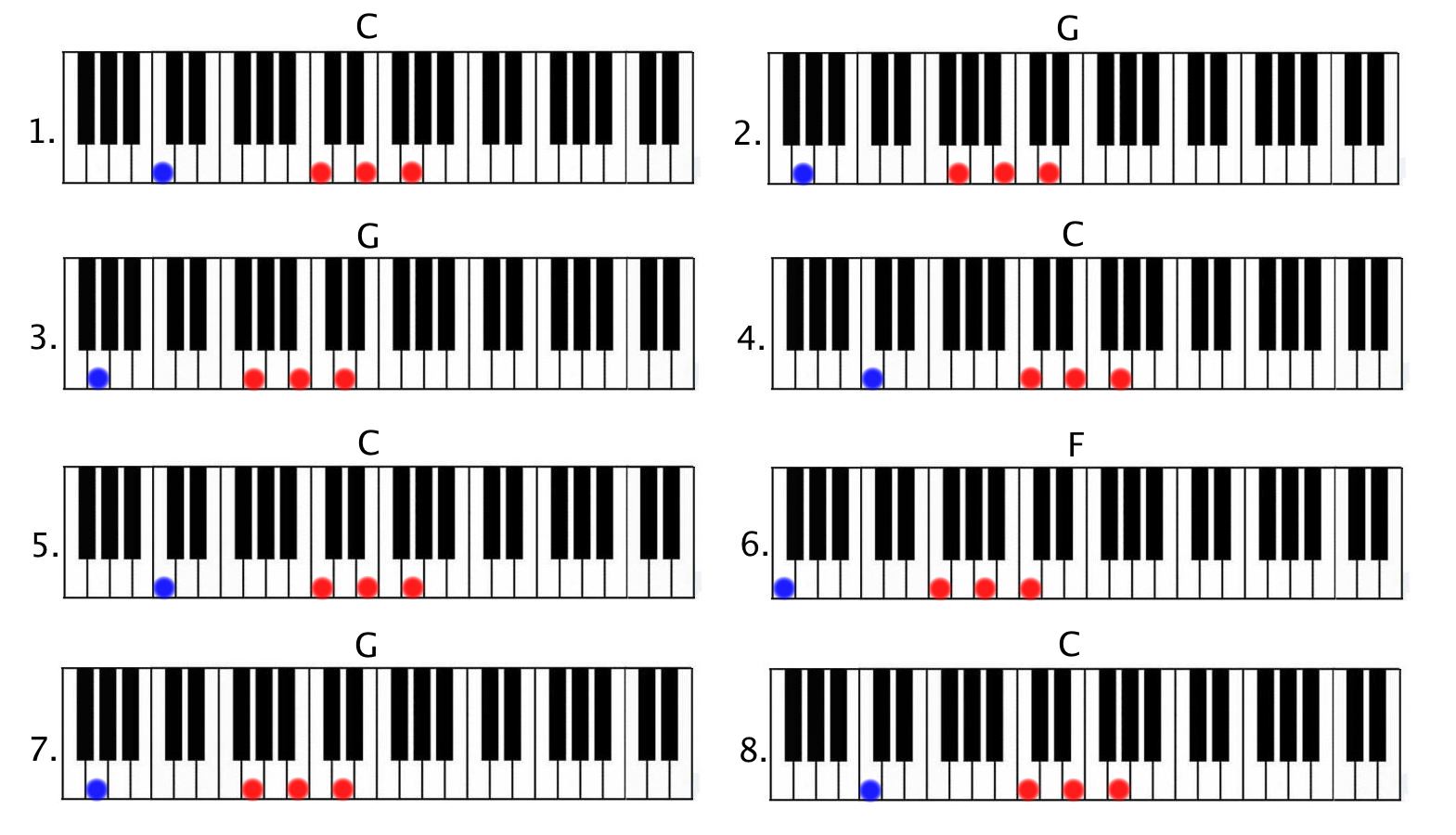
Tip: if this is difficult for you (and by “difficult” I mean – impossible; we’re learning something here so it’s fine if you’re struggling – pushing your limits. That means you’re growing), try to first play the right hand chords separately (no left hand bass notes) a few times.
Then play only the bass notes with your left hand, like this:
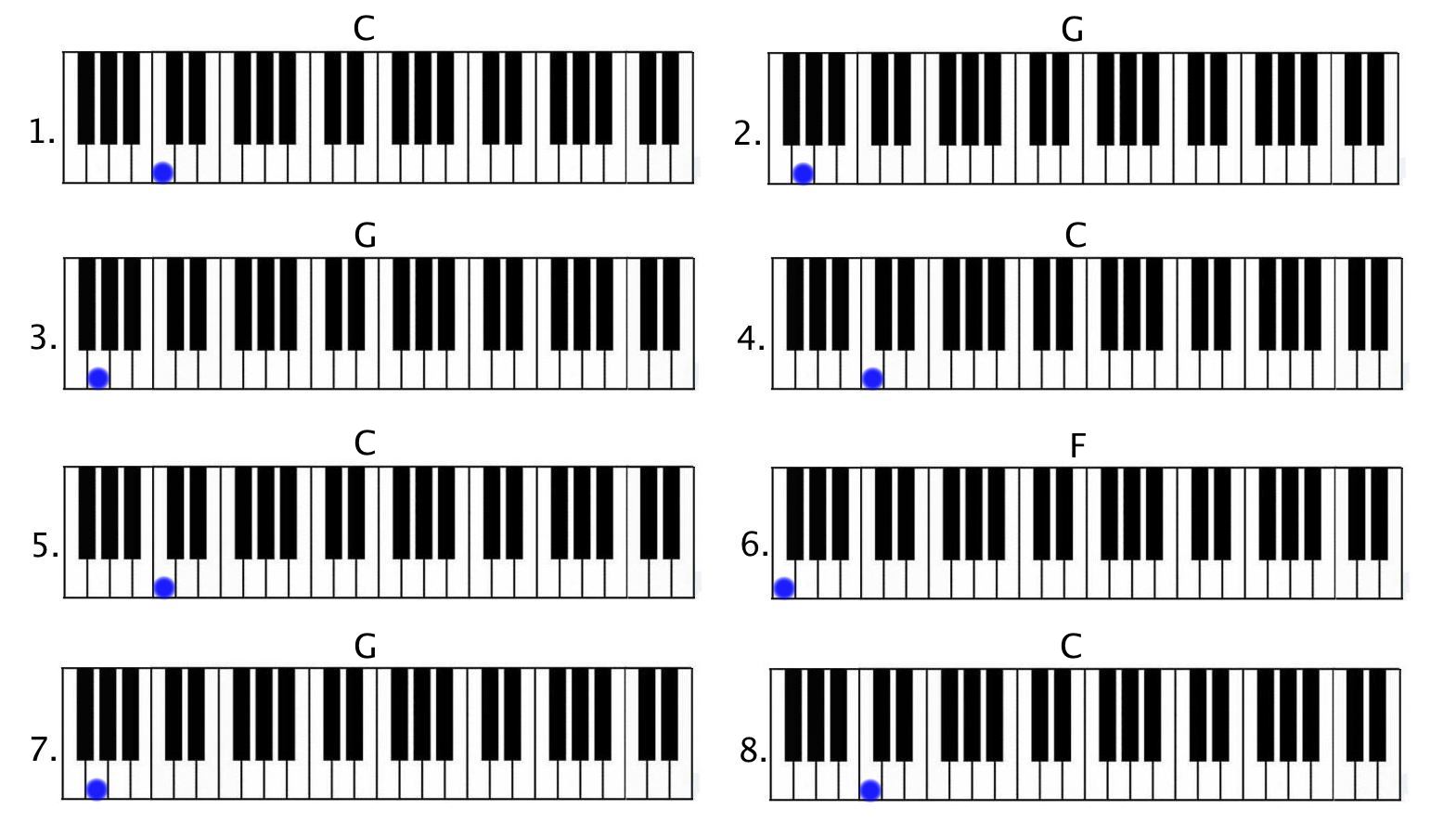 and after you’ve done that a few times, add the right hand chords – playing both hands simultaneously.
and after you’ve done that a few times, add the right hand chords – playing both hands simultaneously.
Do you hear how much depth that bass adds to the sound? How full it now sounds?
Bass is as easy as playing the note that the chord is named after – the root of the chord – one octave below the lowest note of the right hand.
But doesn’t it ever play more difficult things?
Of course it does, but we’re starting at the basis -which already sounds pretty awesome- which is in fact the actual basis of the bass – the starting point from which the bass “thinks” and bass lines emerge – It is in fact the basis of music in its whole.
Check this out:
Huh? Weren’t C G and F the chords of Happy Birthday?
Well yes definitely. However, just like words, chords can be used in many different sentences and conversations.
Like a set of words put in different orders form different sentences, mixing up chords and combining them with different rhythms is how different songs are built and “spoken.”
As a final challenge, before I leave you to mess around with the stuff learnt above: to develop creativity and a good feel for music, try to play the chords you now know, in a few different orders and see what you think sounds good. Don’t be afraid, just bash away! (for example: F F G C – G C G C F – C F C F G C – whatever! Experiment. Get creative. Maybe even try adding a bit of rhythm?).
In the next lesson we'll get our very first taste of musical "flow" by adding some rhythm. That's where the party really starts 😉
Have fun and see ya next one!
Cheers, Coen.
Full lesson video:
